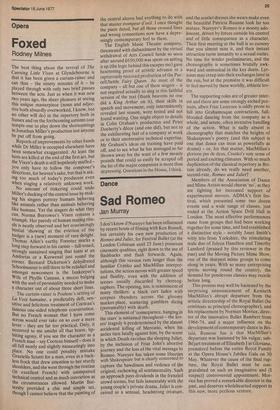Dance
Sad Romeo
Jan Murray
I don't know if Nureyev has been influenced by recent bouts of filming with Ken Russell, but certainly his own new production of Romeo and Juliet, for Festival Ballet (at the London Coliseum until 25 June) possesses cinematic qualities, right down to the use of flashbacks and flash forwards. Again, although this version runs longer than the familiar Cratiko and MacMillan interpretations, the action moves with greater speed and fluidity, even with the addition of scenes usually discarded by choreographers. The opening, too, is reminiscent of many thrillers: a black cart laden with corpses thunders across the gloomy market-place, scattering gamblers dicing (presumably) with death.
This element of 'consequence, hanging in the stars' is sustained throughout — the lovers' tragedy is predetermined by the almost accidental killing of Mercutio, when his antics turn fatally against him, by the scene in which Death ravishes the sleeping Juliet, by the inclusion of Friar John's abortive journey and the loss of the vital message to Romeo. Nureyev has taken some liberties with Shakespeare but is clearly concerned to capture the bawdiness and violence of the original, eschewing all sentimentality. Such an approach pays dividends in the frenzied crowd scenes, but fails lamentably with the young couple's private drama. Juliet is conceived as a sensual, headstrong creature,
and the scarlet dresses she wears make even the beautiful Patricia Ruanne look far too mature. Nureyev's Romeo is a moony adolescent, driven by forces outside his control and of little consequence as a character. Their first meeting at the ball is so cursory that you almost miss it, and their instant attraction turns instantly to a sexual outlet. No time for tender preliminaries, and the choreography is sometimes brutally awkward and unmusical in the key duets. Lyricism may creep into their exchanges later in the run, but at the premiere it was difficult to feel moved by these worldly, athletic lovers.
The supporting roles are of greater interest and there are some strongly etched portraits, albeit Friar Laurence is oddly prone to fall into Grahamesque contractions, fullblooded dancing from the company as a whole, and astute, often inventive handling of the action. What is sadly absent is choreography that matches the heights of Shakespeare's poetry (and this subject is one that dance can treat as powerfully as drama) — or, for that matter, MacMillan's glorious pas de deux, Cranko's sure sense of period and exciting climaxes. With so much duplication of the classical repertory in Britain already, do we really need another, second-rate, Romeo and Juliet?
Members of the Association of Dance and Mime Artists would chorus 'no', as they are fighting for increased support of experimental movers. ADMA's first festival, which presented some two dozen events and a wide range of classes, just ended at the Action Space Drill Hall in London. The most effective performances came from groups that had been working together for some time, and had established a distinctive style — notably Janet Smith's witty trio from Yorkshire, the stimulating male duo of Julyen Hamilton and Timothy Lamford (praised by this reviewer in the past) and the Moving Picture Mime Show, one of the sharpest mime groups to come along in years. With so many enterprising spirits moving round the country, the demand for ponderous classics may recede before long.
This process may well be hastened by the surprising announcement of Kenneth MacMillan's .abrupt departure from the artistic directorship of the Royal Ballet (he continues as principal choreographer), and his replacement by Norman Morrice, director of the innovative Ballet Rambert from 1966-74, and a major influence on the development of contemporary dance in Britain. Rumour has it that MacMillan's departure was hastened by his vulgar, subBejart treatment of Elizabeth I in Gloriana, premiered before the entire Royal Family at the Opera House's Jubilee Gala on 30 ' May. Whatever the cause of the final rupture, the Royal Ballet must be congratulated on such an imaginative and (I suspect) controversial appointment. Morrice has proved a remarkable director in the past, and deserves wholehearted support in this new, more perilous venture.


































 Previous page
Previous page